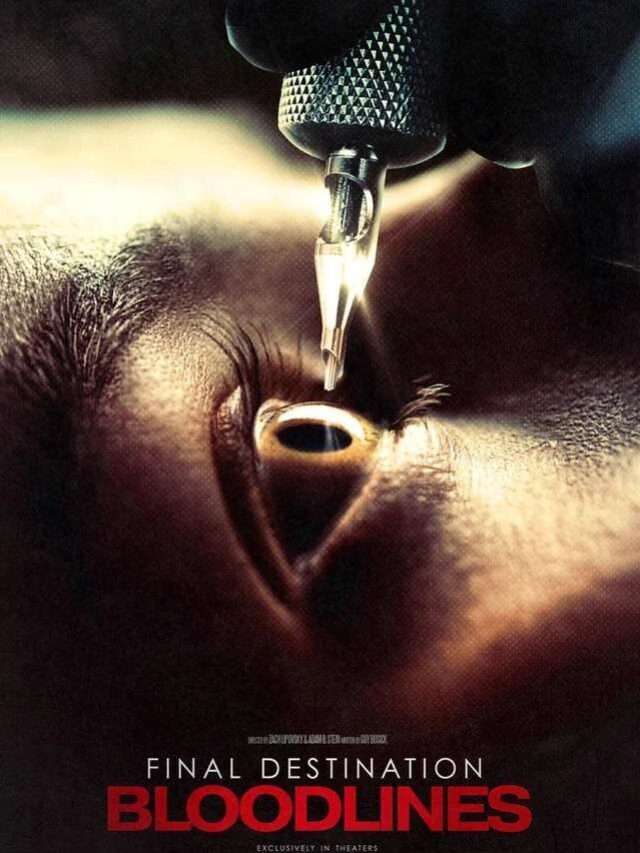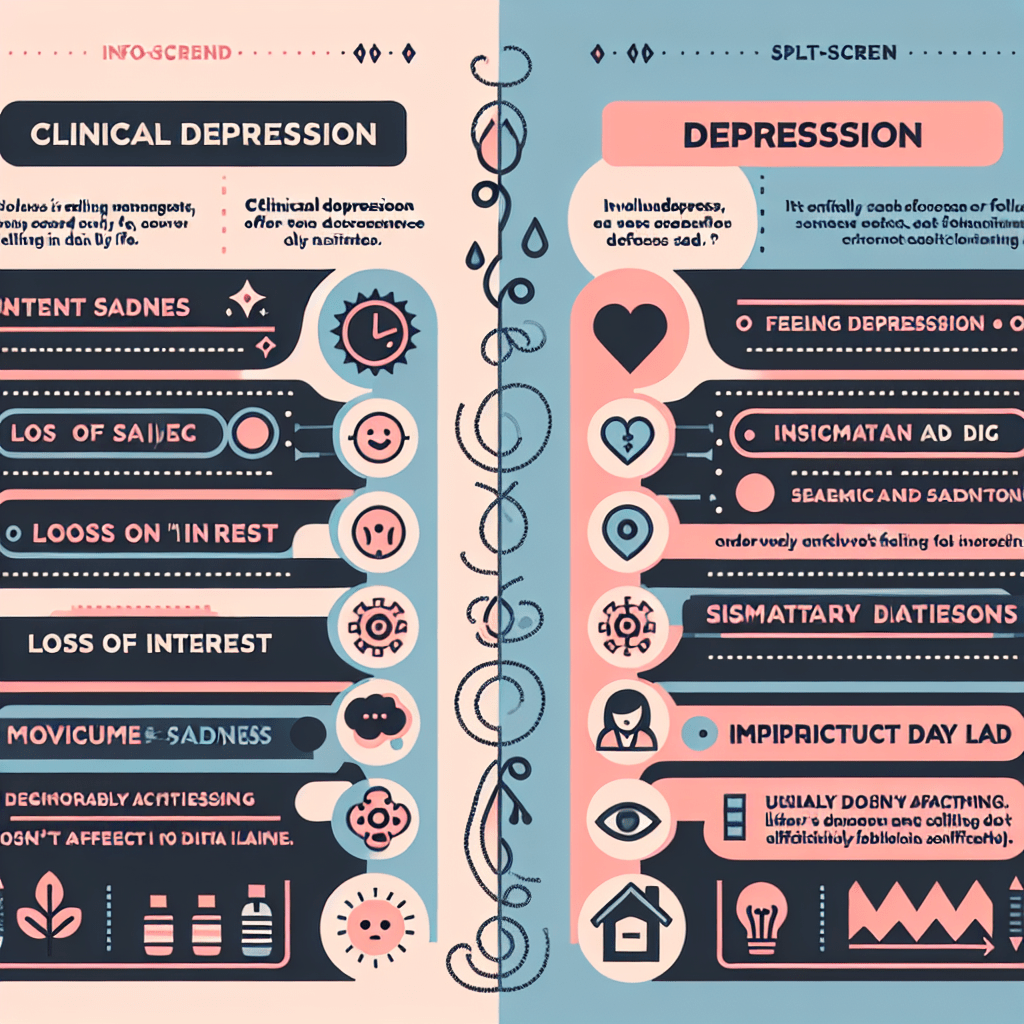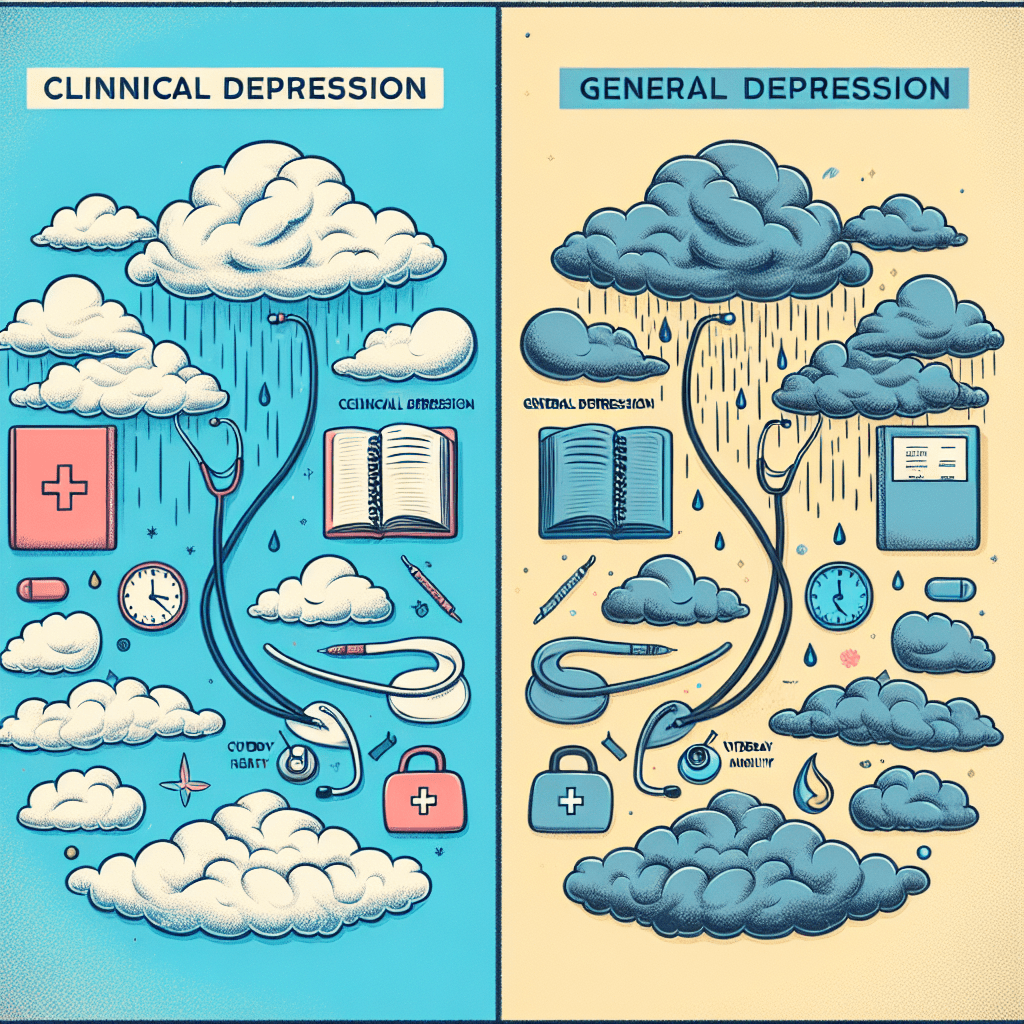What Is The Difference Between Clinical Depression And Depression
Clinical Depression vs. Depression: Understanding the Difference
Introduction
What Is The Difference Between Clinical Depression And Depression
Clinical depression and depression are terms often used interchangeably, but they have distinct differences. Clinical depression refers to a specific mental health disorder characterized by persistent feelings of sadness, hopelessness, and a loss of interest in activities. It is diagnosed based on specific criteria outlined in the Diagnostic and Statistical Manual of Mental Disorders (DSM-5). On the other hand, depression is a broader term that can refer to a temporary state of low mood or sadness that may be caused by various factors. While clinical depression is a diagnosable mental health condition, depression can be a normal reaction to life events or a symptom of other underlying issues.
What Is The Difference Between Clinical Depression And Depression
Understanding the Symptoms and Causes of Clinical Depression vs. Depression
Depression is a common mental health condition that affects millions of people worldwide. It can manifest in various forms, with clinical depression and depression being two terms often used interchangeably. However, there are distinct differences between the two that are important to understand. In this article, we will explore the symptoms and causes of clinical depression versus depression, shedding light on what sets them apart.
Let’s start by clarifying what depression is. Depression is a broad term used to describe a range of emotional and physical symptoms that can affect a person’s daily life. It is characterized by feelings of sadness, hopelessness, and a loss of interest or pleasure in activities once enjoyed. While depression can be a temporary response to life events, such as the loss of a loved one or a major life change, it can also become a chronic condition.
On the other hand, clinical depression, also known as major depressive disorder (MDD), is a more severe and persistent form of depression. It is diagnosed when a person experiences a combination of symptoms that significantly impair their ability to function in daily life for at least two weeks. These symptoms may include persistent feelings of sadness, fatigue, changes in appetite and sleep patterns, difficulty concentrating, and thoughts of self-harm or suicide.
One key difference between clinical depression and depression is the duration and intensity of symptoms. While depression can come and go, clinical depression tends to be more persistent and severe. It can last for months or even years, causing significant distress and interfering with a person’s ability to carry out their usual activities.
Another difference lies in the potential causes of these conditions. Depression can be triggered by various factors, such as stressful life events, hormonal changes, or a family history of the condition. It can also be influenced by environmental factors, such as a lack of social support or exposure to trauma. Clinical depression, on the other hand, is believed to have a stronger biological basis. It is thought to be caused by an imbalance of neurotransmitters in the brain, such as serotonin, which plays a crucial role in regulating mood.
It is important to note that while clinical depression is a more severe form of depression, not everyone with depression will develop clinical depression. However, it is crucial to seek professional help if you or someone you know is experiencing persistent and debilitating symptoms of depression. A mental health professional can provide an accurate diagnosis and recommend appropriate treatment options, which may include therapy, medication, or a combination of both.
In conclusion, while depression and clinical depression share some similarities, they are distinct conditions with different levels of severity and duration. Depression refers to a range of emotional and physical symptoms that can affect a person’s daily life, while clinical depression is a more severe and persistent form of the condition. Understanding the symptoms and causes of these conditions can help individuals seek the appropriate support and treatment they need to improve their mental well-being. Remember, you are not alone, and there is help available for those struggling with depression or clinical depression.
What Is The Difference Between Clinical Depression And Depression
Exploring the Impact of Clinical Depression and Depression on Daily Life
Depression is a term that is often used to describe a feeling of sadness or low mood. However, there is a distinction between clinical depression and depression. Understanding this difference is crucial in order to provide the right support and treatment for individuals who are struggling with their mental health.
Clinical depression, also known as major depressive disorder, is a mental health condition that goes beyond the normal ups and downs of life. It is characterized by persistent feelings of sadness, hopelessness, and a loss of interest in activities that were once enjoyable. People with clinical depression often experience changes in appetite and sleep patterns, have difficulty concentrating, and may even have thoughts of self-harm or suicide.
On the other hand, depression is a broader term that can refer to a range of mental health conditions. It can include clinical depression, but it can also encompass other forms of depression such as situational depression or persistent depressive disorder. Situational depression is a temporary condition that arises in response to a specific event or situation, such as the loss of a loved one or a major life change. Persistent depressive disorder, also known as dysthymia, is a milder but long-lasting form of depression that can persist for years.
Both clinical depression and depression can have a significant impact on daily life. Individuals who are dealing with these conditions often find it difficult to carry out their usual activities and responsibilities. They may struggle with maintaining relationships, performing well at work or school, and taking care of their physical health. The constant feelings of sadness and hopelessness can make even the simplest tasks feel overwhelming.
In addition to the emotional and psychological impact, clinical depression and depression can also have physical symptoms. Fatigue, changes in appetite, and sleep disturbances are common in both conditions. Individuals may also experience physical pain, such as headaches or stomachaches, that have no apparent medical cause. These physical symptoms can further contribute to the overall sense of distress and make it even more challenging to function on a daily basis.
It is important to note that clinical depression and depression are not a sign of weakness or a character flaw. They are legitimate medical conditions that require proper diagnosis and treatment. Seeking help from a mental health professional is crucial in order to receive an accurate diagnosis and develop an appropriate treatment plan.
Treatment for clinical depression and depression can include a combination of therapy, medication, and lifestyle changes. Therapy, such as cognitive-behavioral therapy, can help individuals identify and change negative thought patterns and develop coping strategies. Medication, such as antidepressants, can help regulate brain chemicals that are imbalanced in depression. Making lifestyle changes, such as engaging in regular exercise, practicing stress management techniques, and maintaining a healthy diet, can also have a positive impact on mental health.
In conclusion, while depression is a term that is often used to describe a feeling of sadness, there is a distinction between clinical depression and depression. Clinical depression is a specific mental health condition that goes beyond the normal ups and downs of life, while depression is a broader term that can encompass various forms of depression. Both clinical depression and depression can have a significant impact on daily life, affecting relationships, work, and overall well-being. Seeking help from a mental health professional is crucial in order to receive an accurate diagnosis and develop an appropriate treatment plan. Remember, you are not alone, and there is support available to help you navigate through these challenging times.
What Is The Difference Between Clinical Depression And Depression
Recognizing the Importance of Proper Diagnosis: Clinical Depression vs. Depression
Depression is a common mental health condition that affects millions of people worldwide. It can manifest in various ways and can have a significant impact on a person’s daily life. However, not all depression is the same. There is a distinction between clinical depression and depression, and understanding this difference is crucial for proper diagnosis and treatment.
Clinical depression, also known as major depressive disorder (MDD), is a severe form of depression that lasts for an extended period. It is characterized by persistent feelings of sadness, hopelessness, and a loss of interest in activities that were once enjoyable. People with clinical depression often experience changes in appetite and sleep patterns, have difficulty concentrating, and may even have thoughts of self-harm or suicide.
On the other hand, depression is a broader term that encompasses a range of depressive disorders, including clinical depression. It can refer to a temporary state of sadness or feeling down, which is a normal part of life. For example, feeling depressed after the loss of a loved one or experiencing a significant life event is a natural response. However, if these feelings persist for an extended period and interfere with daily functioning, it may indicate clinical depression.
Recognizing the difference between clinical depression and depression is essential because it affects the approach to treatment. Clinical depression often requires professional intervention, such as therapy and medication, to manage symptoms effectively. On the other hand, depression that is not classified as clinical may be alleviated through self-care practices, support from loved ones, and lifestyle changes.
Proper diagnosis is crucial in distinguishing between clinical depression and depression. A healthcare professional, such as a psychiatrist or psychologist, can conduct a thorough evaluation to determine the severity and duration of symptoms. They may use diagnostic criteria outlined in the Diagnostic and Statistical Manual of Mental Disorders (DSM-5) to make an accurate diagnosis.
It is important to note that clinical depression is a medical condition that requires medical treatment. It is not something that can be overcome by simply “snapping out of it” or “thinking positively.” It is a complex condition that involves a combination of biological, psychological, and environmental factors. Seeking professional help is crucial for managing clinical depression effectively.
However, it is equally important not to dismiss or trivialize the experiences of individuals who may not meet the criteria for clinical depression but still struggle with depressive symptoms. Depression, regardless of its severity, can have a significant impact on a person’s well-being and quality of life. Offering support, understanding, and empathy to those experiencing depression can make a world of difference.
In conclusion, recognizing the difference between clinical depression and depression is vital for understanding the severity and appropriate treatment options. Clinical depression is a severe form of depression that requires professional intervention, while depression can refer to a broader range of depressive disorders. Seeking proper diagnosis and treatment is crucial for managing clinical depression effectively, while offering support and understanding to those experiencing depression is essential regardless of its severity. Remember, mental health matters, and seeking help is a sign of strength.
What Is The Difference Between Clinical Depression And Depression
Treatment Approaches for Clinical Depression and Depression: Similarities and Differences
When it comes to mental health, it’s important to understand the differences between clinical depression and depression. While the terms are often used interchangeably, they actually refer to two distinct conditions. Clinical depression, also known as major depressive disorder, is a more severe and persistent form of depression. It is characterized by intense feelings of sadness, hopelessness, and a loss of interest in activities that were once enjoyable. On the other hand, depression is a broader term that can refer to a range of mood disorders, including clinical depression.
When it comes to treatment approaches, there are both similarities and differences between clinical depression and depression. In both cases, therapy can be an effective treatment option. Cognitive-behavioral therapy (CBT) is a commonly used approach that helps individuals identify and change negative thought patterns and behaviors. This can be beneficial for both clinical depression and depression, as it helps individuals develop healthier coping mechanisms and improve their overall well-being.
Another treatment approach that can be effective for both conditions is medication. Antidepressant medications, such as selective serotonin reuptake inhibitors (SSRIs), are often prescribed to help alleviate symptoms of depression. These medications work by increasing the levels of certain chemicals in the brain that are associated with mood regulation. While medication can be helpful for both clinical depression and depression, it is important to note that it is not a cure-all solution. It is often used in conjunction with therapy and other lifestyle changes to achieve the best results.
In addition to therapy and medication, lifestyle changes can also play a significant role in the treatment of both clinical depression and depression. Regular exercise, for example, has been shown to have a positive impact on mood and overall mental well-being. Engaging in activities that bring joy and fulfillment, such as hobbies or spending time with loved ones, can also help alleviate symptoms of both conditions.
While there are similarities in the treatment approaches for clinical depression and depression, there are also some differences. For individuals with clinical depression, more intensive treatment options may be necessary. This can include inpatient treatment programs or intensive outpatient programs that provide a higher level of care and support. These programs often involve a combination of therapy, medication management, and other therapeutic interventions.
On the other hand, individuals with depression may find that less intensive treatment options are effective. This can include regular therapy sessions, medication management, and lifestyle changes. The severity and duration of symptoms will often determine the appropriate level of treatment.
In conclusion, while clinical depression and depression are related conditions, they have distinct differences. Treatment approaches for both conditions can include therapy, medication, and lifestyle changes. However, individuals with clinical depression may require more intensive treatment options. It is important to seek professional help to determine the most appropriate treatment approach for your specific situation. Remember, you are not alone, and there is help available to support you on your journey to better mental health.
What Is The Difference Between Clinical Depression And Depression
Conclusion
In conclusion, the main difference between clinical depression and depression is that clinical depression refers to a more severe and persistent form of depression that meets specific diagnostic criteria outlined in the Diagnostic and Statistical Manual of Mental Disorders (DSM-5). On the other hand, depression is a broader term that can encompass a range of depressive symptoms and experiences. Clinical depression often requires professional intervention and treatment, while depression can vary in intensity and duration.
























